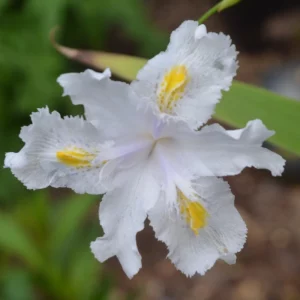
Iris Japonica ‘nada’
April showers bring May flowers! Every one of us can hum along with that oldie but goodie. And it’s true. Well, except in the Lowcountry.
April is one our driest months, but we do seem to get enough to wake up lots of bulbs and perennials from their winter naps. August is historically our rainiest month, with the driest season beginning in mid-September and lasting until the end of May.
Regardless of the rain, or lack of it, our gardens are at the peak of beauty at the end of May. Amaryllis are bursting with huge, orchid-like blossoms that are impossibly beautiful. Lilies . . . the true lilies, also have huge, impressive flowers, but they tend to be short lived perennials. Unless, of course, we have what we in the Lowcountry call “a very harsh winter” which is needed to give them the dormancy and rest they require to keep coming back. Even though they may act as annuals, they are so worth it.
I love all bulbs, corms and tubers. Rhizomes, too. These are plants that “bring their own lunch,” so to speak. These underground lunch boxes contain the nutrients provided by last year’s dying foliage. The new little rootlets continue to feed on the nourishment provided by the mama plant’s foliage until the soil takes over the job. And so the cycle continues.
Irises, too, are among the most successful of geophytes (all those with underground food banks). True, those bearded German irises are a challenge for most of us to grow, but when they are successful, they are breathtakingly beautiful. My favorite, though, is a one with many tiny 2” white blossoms all along the stem. Iris japonica ‘Nada’ or Butterfly Iris. It can be a thug, but I welcome it nonetheless because I transplant it everywhere.
And there the Crinums. Also called Crinum lilies, they are absolutely tough as nails and one of the most enthusiastic reproducers in the Lowcountry. A small clump will turn into one the size of a Winnebago in no time. I must have shared clumps to a hundred friends and given dozens as door prizes at Lunch and Learn.
Right up there with the Crinums is the Swamp Lily or Hymenocallis. It’s weirdly beautiful with white 3” trumpet shaped flowers with long whiskers coming from the rim of the trumpet. Gorgeous! You would need a backhoe to dig a 3 year old clump.
Underrated is the Crocosmia, or Montbresia. This unique corm has the ability to corkscrew deeper into the soil, which makes it harder to eradicate once it gains a foothold in your garden. Some consider it an unattractive invasive species because
it spreads so easily and tends to flop over. However, they can be well behaved if you surround then with a hoop support like they do with peonies up north. Pretty red or orange flowers are eye-catching in the garden.
Sadly, most tulips and narcissus are difficult if not impossible to perennialize in the Lowcountry. However, some old species do fairly well down here, and cultivars, too, if you cool the bulbs in your refrigerator over the winter and plant them in the spring.
Watch out for those pernicious weed seeds. They can live in the soil seed ‘bank’ for more than 40 years. The best way to prevent their getting a strangle-hold on your garden is a thick layer of mulch. Remember, they can and will grow through a crack in cement and asphalt! A layer of cardboard or newspaper under the mulch will block the light and smother existing weeds and prevent new ones from germinating. Weed seeds are as enthusiastic as a group of first graders at recess.
All that being said, welcome spring with open arms and a deep breath of fresh air.
Don’t keep your mouth open, though. The no-see-ums welcome spring, too, and a deep breath of them is something you don’t want to experience.
Look out for a new book recently published by my fellow columnist, Wendy Hilty, that was written especially for gardeners in the Lowcountry. A non-textbook type tome with beautiful photographs from her own garden and a heathy helping of humor and information about successful gardening in this unique climate. It’s called “How to be a Successful Comya Gardener” and can be found at several local nurseries and Lunch and Learn on Saturdays. For those who don’t speak Gullah, ‘Comya’ means ‘newcomer.’









